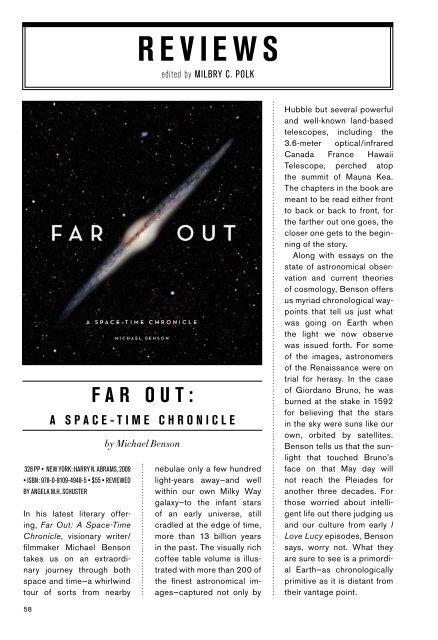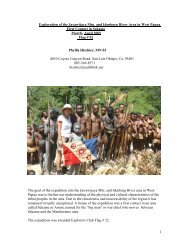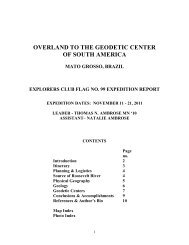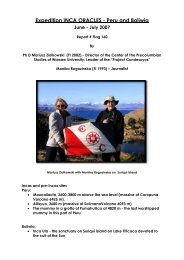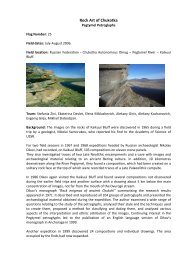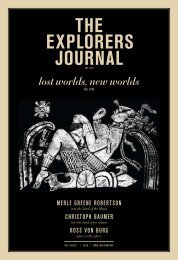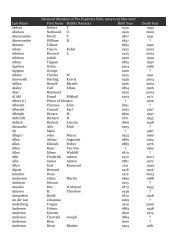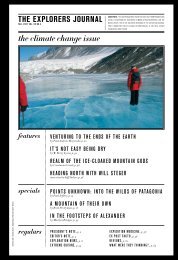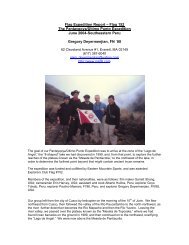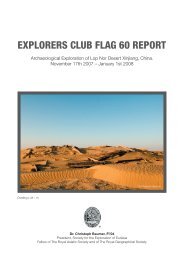the explorers journal - The Explorers Club
the explorers journal - The Explorers Club
the explorers journal - The Explorers Club
You also want an ePaper? Increase the reach of your titles
YUMPU automatically turns print PDFs into web optimized ePapers that Google loves.
e v i e w s<br />
edited by Milbry C. Polk<br />
328 pp • New York: Harry n. Abrams, 2009<br />
• ISBN: 978-0-8109-4948-5 • $55 • Reviewed<br />
by Angela M.H. Schuster<br />
In his latest literary offering,<br />
Far Out: A Space-Time<br />
Chronicle, visionary writer/<br />
filmmaker Michael Benson<br />
takes us on an extraordinary<br />
journey through both<br />
space and time—a whirlwind<br />
tour of sorts from nearby<br />
F a r O u t :<br />
A s p a c e - t i m e C h r o n i c l e<br />
by Michael Benson<br />
nebulae only a few hundred<br />
light-years away—and well<br />
within our own Milky Way<br />
galaxy—to <strong>the</strong> infant stars<br />
of an early universe, still<br />
cradled at <strong>the</strong> edge of time,<br />
more than 13 billion years<br />
in <strong>the</strong> past. <strong>The</strong> visually rich<br />
coffee table volume is illustrated<br />
with more than 200 of<br />
<strong>the</strong> finest astronomical images—captured<br />
not only by<br />
Hubble but several powerful<br />
and well-known land-based<br />
telescopes, including <strong>the</strong><br />
3.6-meter optical/infrared<br />
Canada France Hawaii<br />
Telescope, perched atop<br />
<strong>the</strong> summit of Mauna Kea.<br />
<strong>The</strong> chapters in <strong>the</strong> book are<br />
meant to be read ei<strong>the</strong>r front<br />
to back or back to front, for<br />
<strong>the</strong> far<strong>the</strong>r out one goes, <strong>the</strong><br />
closer one gets to <strong>the</strong> beginning<br />
of <strong>the</strong> story.<br />
Along with essays on <strong>the</strong><br />
state of astronomical observation<br />
and current <strong>the</strong>ories<br />
of cosmology, Benson offers<br />
us myriad chronological waypoints<br />
that tell us just what<br />
was going on Earth when<br />
<strong>the</strong> light we now observe<br />
was issued forth. For some<br />
of <strong>the</strong> images, astronomers<br />
of <strong>the</strong> Renaissance were on<br />
trial for herasy. In <strong>the</strong> case<br />
of Giordano Bruno, he was<br />
burned at <strong>the</strong> stake in 1592<br />
for believing that <strong>the</strong> stars<br />
in <strong>the</strong> sky were suns like our<br />
own, orbited by satellites.<br />
Benson tells us that <strong>the</strong> sunlight<br />
that touched Bruno’s<br />
face on that May day will<br />
not reach <strong>the</strong> Pleiades for<br />
ano<strong>the</strong>r three decades. For<br />
those worried about intelligent<br />
life out <strong>the</strong>re judging us<br />
and our culture from early I<br />
Love Lucy episodes, Benson<br />
says, worry not. What <strong>the</strong>y<br />
are sure to see is a primordial<br />
Earth—as chronologically<br />
primitive as it is distant from<br />
<strong>the</strong>ir vantage point.<br />
58


